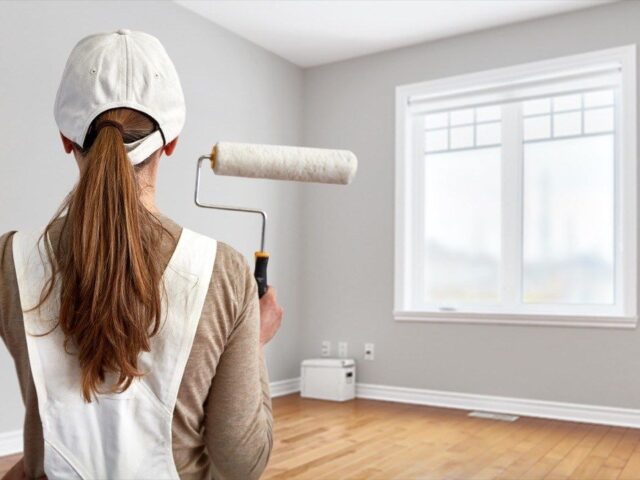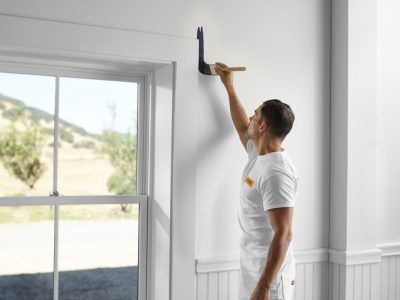Enhance Your Interior Decoration With Comprehensive Color Examination
The integration of color assessment right into indoor design presents a distinct chance to refine and raise the psychological and visual resonance of a space. By engaging with an experienced shade specialist, you can navigate the intricacies of color selection, guaranteeing that your selections not just enhance architectural functions however additionally reverberate with individual design and psychological impact.
Benefits of Color Consultation

Additionally, shade consultation aids in maximizing natural light and optimizing spatial understanding. Lighter hues can make a room show up more expansive, while darker tones develop an intimate setting. Cleveland Metro Painting Specialists. This tactical application of color can significantly affect the overall atmosphere of any interior space
In addition, professional experts possess a thorough understanding of current fads and classic standards, making sure that the chosen colors will certainly continue to be appealing over time. This insight can conserve clients from costly redesigns in the future. Color appointment encourages clients by offering them with a clear vision and instructions, promoting confidence in their layout choices and inevitably leading to a much more effective and rewarding indoor style outcome.
Understanding Shade Psychology
The importance of color psychology in indoor design can not be overstated, as it explores the psychological and psychological impacts that various hues can stimulate in people. Shades can affect mood, habits, and even performance, making them a crucial factor to consider in any type of design job.
For instance, cozy colors such as red, orange, and yellow are often linked with power and warmth. They can promote feelings of exhilaration and comfort, making them ideal for social areas like living cooking areas or spaces. Conversely, cool shades like blue, eco-friendly, and purple often tend to stimulate calmness and harmony, making them suitable for bedrooms or reflection areas.
Furthermore, making use of neutral tones can develop a well balanced environment by enabling the bolder shades to stand out without frustrating the detects. Understanding these emotional impacts enables designers to develop spaces that not just look cosmetically pleasing but additionally promote emotional wellness.
Incorporating shade psychology right into interior decoration entails a thoughtful option of hues customized to the intended feature of each space, eventually boosting the overall experience for its occupants. This understanding is essential for accomplishing a useful and unified interior environment.
The Color Wheel Discussed
It consists of main colors-- red, blue, and yellow-- that can not be produced by blending other colors. Tertiary colors result from mixing a primary and a secondary shade, leading to colors such as turquoise and red-orange.
The shade wheel aids developers understand the relationships in between colors, including complementary, similar, and triadic systems. Corresponding colors, positioned contrary each various other on the wheel, develop vibrant contrasts that can stimulate a like it room.
Utilizing the color wheel in indoor layout not only enhances aesthetic allure however likewise stimulates details feelings and atmospheres, making it a critical reference for color appointment. Comprehending these relationships eventually equips designers to create areas that are both visually fascinating and useful.
Selecting the Right Combination
Commonly, selecting the ideal combination is a definitive consider accomplishing an effective interior decoration job. An appropriate color design can combine a space, boost its go now attributes, and stimulate preferred emotions. To begin, consider the purpose of the area. Different spaces offer different functions and call for combinations that reflect their desired usage; as an example, peaceful colors such as soft blues or environment-friendlies function well in rooms, advertising relaxation.
Light can substantially change just how colors appear, so it is vital to examine the space at various times of the day. An unified scheme should match these attributes, developing a natural appearance throughout the area.
When picking colors, utilize the 60-30-10 guideline, which suggests that 60% of the space should be a dominant shade, 30% a secondary color, and 10% an accent color. This ratio ensures equilibrium and visual interest (Cleveland Metro Painting Specialists). Ultimately, example Visit Website shades on the walls before committing, as this allows you to see exactly how the shades connect with each other and the total setting they develop in your interior decoration task.
Dealing With a Shade Expert

When collaborating with a color consultant, the process normally starts with a first consultation. During this meeting, you'll review your vision, choices, and the existing components in your room. The specialist will examine your demands and may recommend certain color combinations that straighten with your goals.
After establishing a direction, the professional will supply samples and visual aids to aid you envision the recommended color pattern. This step is critical, as colors can show up in different ways under varying lights conditions.
In addition, a color consultant can direct you in picking complementary furnishings, art work, and accessories to balance with your chosen combination. By teaming up closely, you can accomplish a refined aesthetic that boosts your interiors and creates an inviting environment. Ultimately, the knowledge of a color consultant can dramatically enhance the total impact of your layout project.
Verdict
In summary, thorough color appointment serves as an essential tool for improving indoor design. By leveraging professional knowledge of shade psychology and spatial characteristics, a tailored color combination can be created to evoke specific feelings and produce an unified setting.
By involving with an experienced color professional, you can navigate the complexities of color selection, making sure that your selections not only enhance building features yet likewise reverberate with individual design and psychological impact. It makes up main shades-- red, blue, and yellow-- that can not be produced by blending various other shades.The color wheel assists designers comprehend the partnerships in between shades, including complementary, similar, and triadic schemes.When choosing shades, use the 60-30-10 regulation, which suggests that 60% of the room ought to be a leading color, 30% a secondary color, and 10% an accent color. By leveraging professional expertise of shade psychology and spatial characteristics, a customized color palette can be developed to evoke certain feelings and produce a harmonious environment.